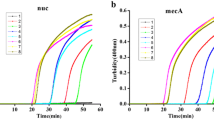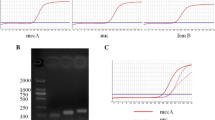Abstract
The purpose of this study was to determine the reliability of the MicroScan WalkAway PosCombo21 (PC21) system for the identification of coagulase-negative staphylococci (CNS) strains and the detection of oxacillin resistance. Using molecular and phenotypic methods, 196 clinical strains were evaluated. The automated system demonstrated 100 % reliability for the identification of the clinical strains Staphylococcus haemolyticus, Staphylococcus hominis and Staphylococcus cohnii; 98.03 % reliability for the identification of Staphylococcus epidermidis; 70 % reliability for the identification of Staphylococcus lugdunensis; 40 % reliability for the identification of Staphylococcus warneri; and 28.57 % reliability for the identification of Staphylococcus capitis, but no reliability for the identification of Staphylococcus auricularis, Staphylococcus simulans and Staphylococcus xylosus. We concluded that the automated system provides accurate results for the more common CNS species but often fails to accurately identify less prevalent species. For the detection of oxacillin resistance, the automated system showed 100 % specificity and 90.22 % sensitivity. Thus, the PC21 panel detects oxacillin-resistant strains, but is limited by the heteroresistance that is observed when using most phenotypic methods.
Similar content being viewed by others
References
Beekmann SE, Diekema DJ, Chapin KC, Doern GV (2003) Effects of rapid detection of bloodstream infections on length of hospitalization and hospital charges. J Clin Microbiol 41:3119–3125
Layer F, Ghebremedhin B, Moder KA, Konig W, Konig B (2006) Comparative study using various methods for identification of Staphylococcus species in clinical specimens. J Clin Microbiol 44:2824–2830
Otto M (2004) Virulence factors of the coagulase-negative staphylococci. Front Biosci 9:841–863
Sader HS, Gales AC, Pfaller MA, Mendes RE, Zoccoli C, Brth A, Jones RN (2001) Pathogen frequency and resistance patterns in Brazilian hospitals: summary of results from three years of the SENTRY Antimicrobial Surveillance Program. Braz J Infect Dis 5:200–214
Heikens E, Fleer A, Paatrw A, Florijn A, Fluit AC (2005) Comparison of genotypic and phenotypic methods for species-level identification of clinical isolates of coagulase-negative staphylococci. J Clin Microbiol 43:2286–2290
Cunha ML, Sinzato YK, Silveira LV (2004) Comparison of methods for the identification of coagulase-negative staphylococci. Mem Inst Oswaldo Cruz 99:855–860
Kloos WE, Schleifer KH (1975) Simplified scheme for routine identification of human Staphylococcus species. J Clin Microbiol 1:82–88
Bannerman TL, Peacock SJ (2003) Staphylococcus, Micrococcus, and other catalase-positive cocci that grown aerobically. In: Murray PR, Barron EJ, Pfaller MA, Tenover FC, Yolken RH (eds) Manual of clinical microbiology, 8th edn. ASM Press, Washington, DC, pp 384–404
Carbonnelle E, Beretti JL, Cottyn S, Quesne G, Berche P, Nassif X, Ferroni A (2007) Rapid identification of staphylococci isolated in clinical microbiology laboratories by matrix-assisted laser desorption ionization-time of flight mass spectrometry. J Clin Microbiol 45:2156–2161
Jin WY, Jang SJ, Lee MJ, Park G, Kim MJ, Kook JK, Kim DM, Moon DS, Park YJ (2011) Evaluation of VITEK 2, MicroScan, and Phoenix for identification of clinical isolates and reference strains. Diagn Microbiol Infect Dis 70:442–447
Barros EM, Iório NLP, Bastos MCF, Santos KRN, Giambiagi-deMarval M (2007) Species-level identification of clinical staphylococcal isolates based on polymerase chain reaction-restriction fragment length polymorphism analysis of a partial groEL gene sequence. Diagn Microbiol Infect Dis 59:251–257
Schuenck RP, Pereira EM, Iorio NL, Santos KRN (2008) Multiplex PCR assay to identify methicillin-resistant Staphylococcus haemolyticus. FEMS Immunol Med Microbiol 52:431–435
Santos OC, Laport MS, Teixeira LM, Giambiagi-deMarval M, Iório NLP, Santos KRN (2009) Reliable identification of clinically prevalent species and subspecies of staphylococci by sodium dodecyl sulfate polyacrylamide gel electrophoresis analysis. Diagn Microbiol Infect Dis 64:1–5
Tomasz A, Nachman S, Leaf H (1991) Stable classes of phenotypic expression in methicillin-resistant clinical isolates of staphylococci. Antimicrob Agents Chemother 35:124–129
Martins A, Cunha MLRS (2007) Methicillin resistance in Staphylococcus aureus and coagulase-negative staphylococci: epidemiological and molecular aspects. Microbiol Immunol 51:787–795
Ramotar K, Bobrowska M, Jessamine P, Toye B (1998) Detection of methicillin resistance in coagulase-negative staphylococci initially reported as methicillin susceptible using automated methods. Diagn Microbiol Infect Dis 30:267–273
MacFaddin JF (1977) Biochemical tests for identification of medical bacteria. Waverly Press, Baltimore
Monsen T, Rönnmark M, Olofsson C, Wiström J (1998) An inexpensive and reliable method for routine identification of staphylococcal species. Eur J Clin Microbiol Infect Dis 17:327–335
Laport M, deCastro AC, Villardo A, Lemos JA, Bastos MC, Giambiagi-deMarval M (2001) Expression of the major heat shock proteins DnaK and GroEL in Streptococcus pyogenes: a comparison to Enterococcus faecalis and Staphylococcus aureus. Curr Microbiol 42:264–268
Clinical Laboratory Standard Institute (2007) Methods for dilution antimicrobial susceptibility tests for bacteria that grow aerobically. Approved Standard: M7-A6. NCCLS, Wayne, Pennsylvania
Santos KRN, Teixeira LM, Leal GS, Fonseca LS, Gontijo-Filho PP (1999) DNA typing of methicillin-resistant Staphylococcus aureus: isolates and factors associated with nosocomial acquisition in two Brazilian university hospitals. J Med Microbiol 48:17–23
Barg NL, Harris T (1997) Toxin-mediated syndromes. In: Crossley KB, Archer GL (eds) The staphylococci in human disease. Churchill Livingstone, New York, pp 527–543
Shuttleworth R, Behme RJ, McNabb A, Colby WD (1997) Human Isolates of Staphylococcus caprae: association with bone and joint infections. J Clin Microbiol 35:2537–2541
Jarlov JO (1999) Phenotypic characteristics of coagulase-negative staphylococci: typing and antibiotic susceptibility. Acta Pathol Microbiol Immunol Scand 107:1S–42S
Drancourt M, Raoult D (2002) rpoB gene sequence-based identification of Staphylococcus species. J Clin Microbiol 40:1333–1338
Iório NLP, Ferreira RBR, Schuenck RP, Malvar KL, Pereira AB, Nunes APF, Bastos CCR, Santos KRN (2007) Simplified and reliable scheme for species-level identification of clinical isolates of Staphylococcus. J Clin Microbiol 45:2564–2569
Saa AI, Tinajas A, Barbeyto L, Rodriguez LA (1999) Evaluation of the MicroScan System for identification of staphylococci. J Basic Microbiol 39:373–376
Lee TF, Lee H, Chen CM, Du SH, Chen YC, Hsu CC, Chung MY, Teng SH, Teng LJ, Hsueh PR (2013) Comparison of the accuracy of matrix-assisted laser desorption ionization—time of flight mass spectrometry system with that of other commercial identification systems at identifying Staphylococcus saprophyticus in urine. J Clin Microbiol 51:1563–1566
Swenson JM, Williams PP, Killgore G, O’Hara CM, Tenover FC (2001) Performance of eight methods, including two new rapid methods, for detection of oxacillin resistance in a challenge set of Staphylococcus aureus organisms. J Clin Microbiol 39:3785–3788
Farrell DJ (1997) The reliability of MicroScan conventional and rapid panels to identify Staphylococcus aureus and detect methicillin resistance: an evaluation using the tube coagulase test and mecA PCR. Pathology 29:406–410
Matthews PR, Stewart PR (1984) Resistance heterogeneity in methicillin-resistant Staphylococcus aureus. FEMS Microbiol Lett 22:161–166
Acknowledgments
We are indebted to Dr. Olinda C. S. Santos for her helpful assistance. This study was supported by Brazilian grants to Marcia Giambiagi-deMarval from: the Fundação Carlos Chagas Filho de Amparo à Pesquisa do Estado do Rio de Janeiro (FAPERJ), the Conselho Nacional de Desenvolvimento Científico e Tecnológico (CNPq), the Coordenação de Aperfeiçoamento Pessoal de Nível Superior (CAPES) and the Programa de Núcleos de Excelência (PRONEX). We thank Orlando dos Santos, in memoriam, for his technical assistance.
Conflict of interest
The authors have no financial relationship with the organisations that sponsored this research, and they declare that they have no conflict of interest.
Author information
Authors and Affiliations
Corresponding author
Rights and permissions
About this article
Cite this article
Olendzki, A.N., Barros, E.M., Laport, M.S. et al. Reliability of the MicroScan WalkAway PC21 panel in identifying and detecting oxacillin resistance in clinical coagulase-negative staphylococci strains. Eur J Clin Microbiol Infect Dis 33, 29–33 (2014). https://doi.org/10.1007/s10096-013-1923-8
Received:
Accepted:
Published:
Issue Date:
DOI: https://doi.org/10.1007/s10096-013-1923-8




